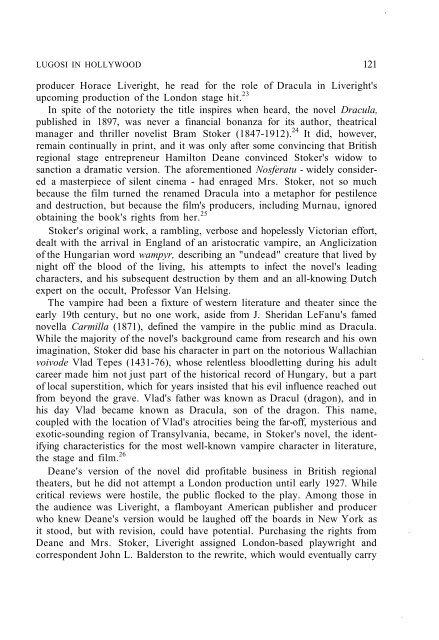HUNGARIAN STUDIES 11. No. 1. Nemzetközi Magyar ... - EPA
HUNGARIAN STUDIES 11. No. 1. Nemzetközi Magyar ... - EPA
HUNGARIAN STUDIES 11. No. 1. Nemzetközi Magyar ... - EPA
- No tags were found...
Create successful ePaper yourself
Turn your PDF publications into a flip-book with our unique Google optimized e-Paper software.
LUGOSI IN HOLLYWOOD 121producer Horace Liveright, he read for the role of Dracula in Liveright'supcoming production of the London stage hit. 23In spite of the notoriety the title inspires when heard, the novel Dracula,published in 1897, was never a financial bonanza for its author, theatricalmanager and thriller novelist Bram Stoker (1847-1912). 24 It did, however,remain continually in print, and it was only after some convincing that Britishregional stage entrepreneur Hamilton Deane convinced Stoker's widow tosanction a dramatic version. The aforementioned <strong>No</strong>sferatu - widely considereda masterpiece of silent cinema - had enraged Mrs. Stoker, not so muchbecause the film turned the renamed Dracula into a metaphor for pestilenceand destruction, but because the film's producers, including Murnau, ignoredobtaining the book's rights from her. 25Stoker's original work, a rambling, verbose and hopelessly Victorian effort,dealt with the arrival in England of an aristocratic vampire, an Anglicizationof the Hungarian word wampyr, describing an "undead" creature that lived bynight off the blood of the living, his attempts to infect the novel's leadingcharacters, and his subsequent destruction by them and an all-knowing Dutchexpert on the occult, Professor Van Helsing.The vampire had been a fixture of western literature and theater since theearly 19th century, but no one work, aside from J. Sheridan LeFanu's famednovella Carmilla (1871), defined the vampire in the public mind as Dracula.While the majority of the novel's background came from research and his ownimagination, Stoker did base his character in part on the notorious Wallachianvoivode Vlad Tepes (1431-76), whose relentless bloodletting during his adultcareer made him not just part of the historical record of Hungary, but a partof local superstition, which for years insisted that his evil influence reached outfrom beyond the grave. Vlad's father was known as Dracul (dragon), and inhis day Vlad became known as Dracula, son of the dragon. This name,coupled with the location of Vlad's atrocities being the far-off, mysterious andexotic-sounding region of Transylvania, became, in Stoker's novel, the identifyingcharacteristics for the most well-known vampire character in literature,the stage and film. 26Deane's version of the novel did profitable business in British regionaltheaters, but he did not attempt a London production until early 1927. Whilecritical reviews were hostile, the public flocked to the play. Among those inthe audience was Liveright, a flamboyant American publisher and producerwho knew Deane's version would be laughed off the boards in New York asit stood, but with revision, could have potential. Purchasing the rights fromDeane and Mrs. Stoker, Liveright assigned London-based playwright andcorrespondent John L. Balderston to the rewrite, which would eventually carry
















